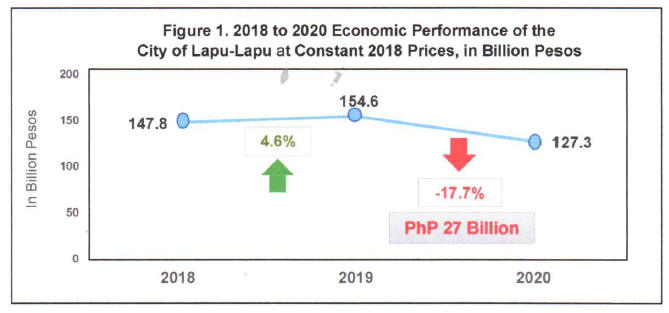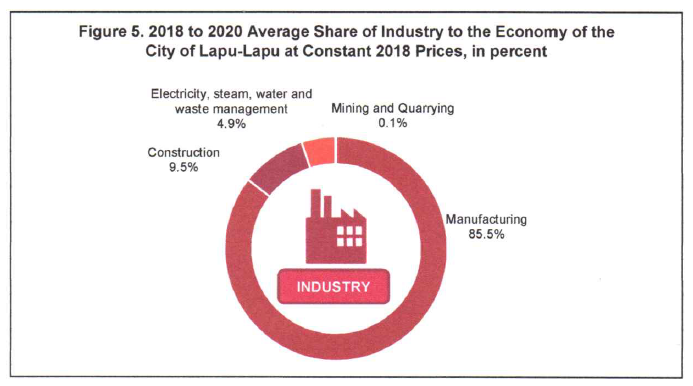The economy of the City of Lapu-Lapu declined by 17.7 percent in 2020
The economy of the City of Lapu-Lapu declined by 17.7 percent in 2020. The total amount of goods and services produced by the city in 2020 was valued at PhP 127.3 billion. This represents a decline of 17.7 percent from the PhP 154.6 billion produce in 2019, while in 2018 it was valued at 147.8 billion pesos. (See Figure 1)

Percentage share of Industries of the City of Lapu-Lapu
The city’s economy was driven by following industries: Manufacturing at 46.4 percent annual average share, followed by Transportation and Storage at 9.1 percent; and Wholesale and Retail Trade, Repair of Motor Vehicles and Motorcycles at 8.6 percent.
In 2020, Agriculture, Forestry and Fishing posted a positive growth of 6.8 percent from 3.7 percent in 2019. Industry and Services posted a negative growth at 12.7 percent and 23.4 percent respectively. Moreover, four industries posted positive growth, these are: Agriculture, Forestry, and Fishing with 6.8 percent, Electricity, Steam, Water and Waste Management with 7.5 percent; Financial and Insurance Activities with 8.1 percent; and Professional and Business Services with 2.9 percent. (See Table 1)

City of Lapu-Lapu is mainly driven by Services among major industry.
Industry has the largest share of the city’s economy accounting to 54.2 percent. This was followed by Services with 45.5 percent and Agriculture, Forestry and Fishing (AFF) taking 0.3 percent.
(See Figure 2)

Contribution of each industry to the total economy of the City of Lapu-Lapu
For the contribution of each industry to the total economy of the City of Lapu-Lapu; in 2019; Services shared 3.6 percentage points to the 4.6 percent increase in 2019. Industry shared 1.0 percentage points and Agriculture, Forestry, and Fishing (AFF) managed to contribute 0.01 percentage point. Meanwhile, in 2020; Services shared a negative -11.0 percentage points to the 17.7 percent decline in 2020. Industry shared -6.7 percentage points while Agriculture, Forestry, and Fishing managed to share the only positive percentage points of 0.02. (See figure 3)

Per Capita Gross Domestic Product of the City of Lapu-Lapu
In 2018, the Per Capita Gross Domestic Product (GDP) of the City of Lapu-Lapu is at PhP 333,629 while in 2019 it was estimated at PhP 340,545 and in 2020 at PhP 274,053. (See Figure 4)

Manufacturing has the largest percentage share of 85.5 percent among Industry
Among Industries, Manufacturing has the largest share with 85.5 percent; followed by Construction with 9.5 percent; Electricity, Steam, Water and Waste Management with 4.9 percent, and Mining and Quarrying with 0.1 percent share. (See Figure 5)

Transportation and Storage has the largest percentage share of 20.4 percent among Services
Among Services, Transportation and Storage had the highest percent share of 20.4 percent from 2018 to 2020. This was followed by Wholesale and Retail trade; Repair of Motor Vehicles and Motorcycles with 18.6 percent share, Real Estate and Ownership of Dwellings with 15.4 percent, Professional and Business Services and with 10.7 percent, Accommodation and Food Services Activities with 10.3 percent, Financial and Insurance Activities with 8.1 percent, Information and Communication with 7.0 percent, Education with 4.5 percent, Other Services with 2.9 percent, Public Administration and Defense; Compulsory Social Activities with 1.1 percent, and Human Health and Social Work Activities contributed 0.9 percent of the total services. (See Figure 6)

Technical Notes:
Provincial Product Accounts (PPA) - is a tool used to measure the economic performance of the province or highly urbanized cities (HUCs) at a given time. It monitors the economic development of the province/HUC and evaluates the progress through time. It also serves as a metric to identify which sector or industry that needs intervention for its sustainability in the province’s economy. PPA intends to strengthen the planning and decision-making of provincial policymakers and stakeholders in crafting more informed economic policies and programs.
Gross Domestic Product (GDP) - is a monetary measure of the market value of all the final goods and services produced in a specific time period.
Measuring the Economic Performance

PSA to start the compilation of the Provincial Product Accounts in 2021, initially with 14 provinces from the regions of MIMAROPA (5 provinces), Central Visayas (4 provinces), and Northern Mindanao (5 provinces).
Measurement of GDP – Production Approach
GDP = ∑ Gross Value Added (GVA) of all industries
Gross Value Added*
equals:
Gross Output
less:
Intermediate Consumption
*by taking away Intermediate consumption, GDP represents unduplicated outputs of the economy
Approved by:
(SGD) FIRMO C. DIPUTADO
Chief Statistical Specialist


